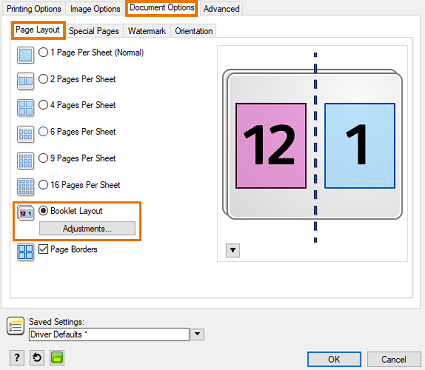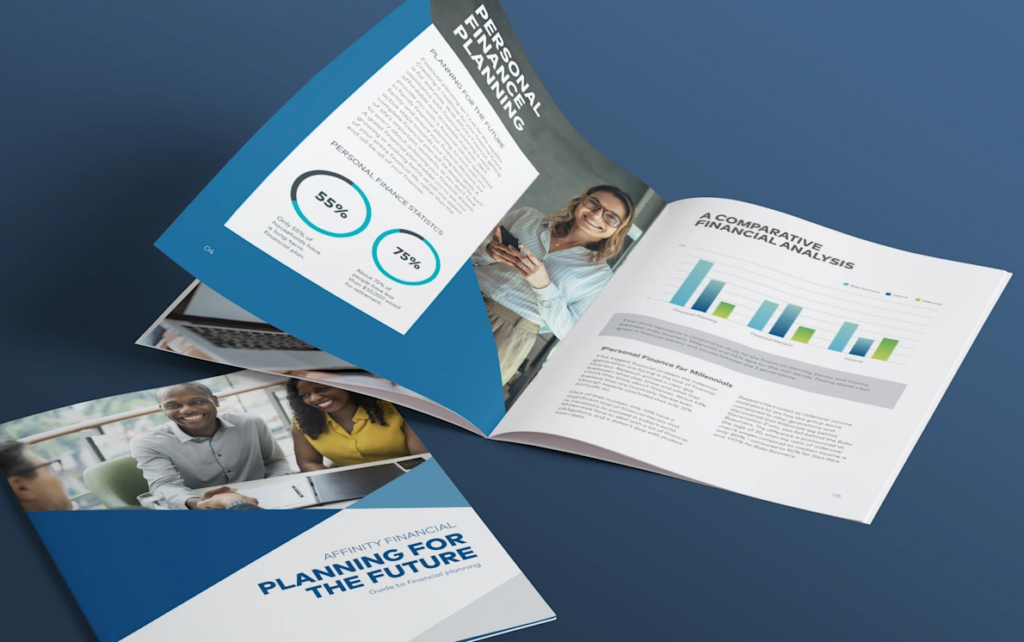How Eco-Conscious Brands Are Using Green Booklet Printing Methods
How Eco-Conscious Brands Are Using Green Booklet Printing Methods
Blog Article
The Necessary Overview to Comprehending Booklet Printing Options and Techniques
The procedure of booklet printing entails multiple factors to consider that can considerably impact the end product. From selecting the appropriate format and size to comprehending the subtleties of binding techniques, each option plays a vital role. Additionally, elements such as paper supply and printing techniques further influence the efficiency of the booklet. As one browses these alternatives, it comes to be essential to realize exactly how they adjoin and what that indicates for the overall outcome.
Understanding Brochure Dimensions and styles
When taking into consideration booklet printing, understanding the various styles and dimensions available is important for achieving the preferred presentation. Brochures can be generated in countless layouts, consisting of saddle-stitched, spiral-bound, and perfect-bound, each offering distinct benefits. Typical dimensions vary from standard letter (8.5 x 11 inches) to smaller sized options like A5 (5.8 x 8.3 inches), permitting for flexibility based upon content and target audience.Selecting the appropriate size can influence both the layout and viewers engagement. Bigger sizes could match aesthetically driven content, while smaller sized formats might be extra mobile and user-friendly. Furthermore, the variety of web pages impacts the selection of binding approach, as thicker brochures might need stronger bindings. Inevitably, recognizing these aspects enables a much more tailored method, making certain that the last item lines up with the desired message and visual, boosting the overall effectiveness of the communication.
Picking the Right Paper Supply

Binding Methods: Considerations and options
When it pertains to binding approaches for booklets, numerous alternatives are available, each with distinctive advantages. Saddle stitch binding supplies an affordable service for thinner brochures, while best binding methods provide a more polished appearance for thicker magazines. Wire-O binding stands out for its resilience and convenience of use, making it excellent for documents that need flexibility.
Saddle Stitch Binding
Saddle stitch binding supplies a affordable and useful solution for assembling booklets, making it a popular option among companies and authors. This binding method involves folding sheets of paper in fifty percent and stapling them along the fold line, producing a organized and neat appearance. Commonly suitable for pamphlets with a reduced web page matter, saddle sewing is perfect for magazines, brochures, and instructional products. The simplicity of this strategy enables quick manufacturing and is often favored for promotional products or brief runs. Nonetheless, it is important to note that saddle stitch binding may not be appropriate for thicker brochures, as the spinal column might not stand up under enhanced weight. On the whole, it stays a reliable choice for numerous printing tasks.
Perfect Binding Techniques
Perfect binding is a widely made use of method that offers a refined and specialist finish to booklets and magazines. This method entails gluing the web pages together at the spine using a strong adhesive, permitting a tidy edge and the capacity to hold a larger number of web pages compared to saddle stitching. Perfect binding is specifically suitable for thicker booklets, such as catalogs and annual records, where a sturdy, level spine is wanted. In addition, it supplies the alternative for a printed cover that can be made to improve visual appeal. However, considerations such as web page matter, paper weight, and the meant use of the booklet ought to be thought about, as they can affect resilience and general quality.
Wire-O Binding Options
Wire-O binding, known for its durability and versatility, supplies an exceptional option for brochures that call for simple page turning and a professional appearance. This binding approach uses a series of steel loops that hold pages securely, enabling them to exist level when open. It is particularly ideal for guidebooks, magazines, and discussions because of its durable nature. Wire-O binding is offered in different colors and diameters, accommodating different web page counts and thicknesses. Furthermore, it permits the addition of tabs and covers, enhancing the booklet's general aesthetic. Factors to consider for Wire-O binding consist of the option of cable color, the dimension of the loops, and the level of customization desired, all of which can profoundly affect the final item's look and performance.
Digital vs. Offset Printing: Which Is Best for You?
When choosing a printing method for brochures, recognizing the distinctions in between digital and balance out printing is essential. Digital printing makes use of contemporary technology to create high-quality prints swiftly and economically, making it excellent for brief runs or projects calling for fast turnaround times. It permits personalization, supplying the ability to print on-demand with minimal waste.In contrast, counter printing is a conventional method that excels in creating large amounts with consistent top quality. It involves moving ink from a plate to a rubber blanket, then to the paper, which leads to dynamic colors and exact details. Nevertheless, counter printing normally needs longer arrangement times and is much more affordable for larger volumes.Ultimately, the option between digital and balance out printing depends on task needs, budget plan, and wanted quantity. For tiny, time-sensitive jobs, digital could be the ideal option, while offset might be more effective for bigger, top Find Out More notch productions.

Designing Your Booklet: Tips and Ideal Practices
When developing a brochure, mindful interest to layout, font style option, and shade usage can substantially improve its efficiency. A well-structured design guides the visitor's eye, while suitable fonts guarantee readability and share the desired tone. In addition, reliable use color can stimulate emotions and highlight key info, making the general style much more impactful.
Selecting the Right Design
Just how can one efficiently select the right layout for a brochure? It is important to evaluate the booklet's function and target audience. A clean, arranged layout boosts readability and interaction. Utilizing a grid system can assist in lining up components consistently, creating an expert appearance. Additionally, integrating aesthetic pecking order via varying dimensions and positionings of pictures and message can direct the viewers's eye and stress crucial information. It is also vital to leave enough white area, which avoids overcrowding and permits far better focus. Lastly, evaluating various designs via mock-ups can offer insight right into how the design performs in real-world scenarios, making sure that the end product fulfills both aesthetic and functional requirements.
Picking Suitable Typefaces
An appropriate font can significantly enhance the general layout of a booklet, enhancing the format and strengthening the material's message. The choice of fonts ought to think about readability, especially for body message, as it ensures the details comes to all readers. Sans-serif typefaces are commonly favored for digital formats, while serif fonts can lend a standard feeling in printed materials. It's suggested to restrict font selections to two or three to maintain aesthetic comprehensibility. Additionally, font dimension plays an important role; headings need to be not frustrating but unique, while body message should be comfortable for reading. When choosing typefaces, positioning with the booklet's theme and target audience is crucial for efficient communication and visual charm.
Efficient Use of Shade
Color works as a powerful device in pamphlet design, leading and forming perceptions visitor emotions. It can stimulate feelings of calmness, trust fund, or excitement, depending on the colors chosen. Designers ought to take into consideration color concept principles, ensuring that the picked scheme straightens with the booklet's message and target audience. For circumstances, making use of cozy shades like red and orange can develop urgency, while cooler tones like blue and eco-friendly foster tranquility.Additionally, comparison plays a vital role; complementary colors can boost readability and visual allure. Uniformity in shade usage across web pages further strengthens brand identification and cohesion. Inevitably, effective shade application not just captures interest however likewise strengthens the booklet's function, making it a necessary aspect of successful layout.
Finishing Touches: Coatings and Unique Impacts
While lots of take into consideration the material and format of a brochure the most crucial elements, the finishing touches, such as finishings and special results, play a vital duty in enhancing its general allure. Coatings can supply protection and toughness, making sure that the brochure endures damage. Matte finishes provide an innovative, non-reflective surface area, while glossy coverings can make shades appear more captivating and vivid. Unique effects, like embossing or foil stamping, include a responsive measurement that can produce an unforgettable impact. These methods can highlight specific locations, accentuating vital information or producing visual interest. Furthermore, UV covering can supply a high-shine coating that boosts the overall look.Together, these finishing touches not just improve the booklet's aesthetic yet likewise interact professionalism and attention to information, eventually leaving a lasting effect on the viewers.
Cost Factors To Consider for Booklet Printing
Comprehending the different cost factors to consider for pamphlet printing is vital for organizations and organizations aiming to enhance their budget plans. Secret elements affecting costs include the choice of binding, paper, and ink approaches. Better products, such as exceptional paper or specialized inks, typically boost the total expense. In addition, the dimension and page matter of the pamphlet play a considerable role; larger pamphlets call for even more sources and time to produce.Another crucial consideration is the printing method, whether digital or balanced out, as each has its own pricing structure and suitability for different amounts. Services must also consider style prices, which can vary based upon intricacy and using specialist solutions. Inevitably, delivery and handling charges can contribute to the total, especially for large orders. By evaluating these components, organizations can make enlightened decisions that straighten with their economic capacities while attaining the preferred top quality in their printed products.
Regularly Asked Inquiries
What Are the Environmental Influences of Booklet Printing?
The ecological influences of booklet printing include deforestation from paper production, carbon exhausts from transport, and waste generation from discarded products - Booklet Printing. Sustainable techniques, such as using recycled paper and environmentally friendly inks, can reduce these effects
Just How Can I Make Sure Shade Accuracy in My Pamphlet?
To assure shade precision in a brochure, one must utilize calibrated screens, employ specialist color profiles, conduct examination prints, and pick high-grade printing services that supply shade matching and proofing alternatives for ideal outcomes.
What Is the Normal Turnaround Time for Booklet Printing?
The normal turnaround time for pamphlet printing differs depending upon the complexity and quantity - Booklet Printing. Generally, it ranges from a couple of days to two weeks, influenced by elements such as printing approaches and ending up demands
Exist Minimum Order Quantities for Brochure Printing?

Can I Publish Brochures in Multiple Languages?
Printing booklets in numerous languages is possible. Lots of printing services offer choices for multilingual or multilingual formats, enabling effective interaction. Careful preparation guarantees that develop components accommodate various languages without jeopardizing readability or aesthetics. Furthermore, aspects such as paper supply and printing strategies further influence the performance of the booklet. When considering booklet printing, understanding the different styles and dimensions offered is vital for accomplishing the wanted discussion. When choosing a printing method for pamphlets, comprehending the differences between digital and offset printing is essential. Additionally, the dimension and page count of the booklet play a substantial role; bigger pamphlets require even why not try these out more sources and time to additional info produce.Another essential consideration is the printing method, whether digital or balanced out, as each has its very own rates structure and suitability for various amounts. The ecological influences of booklet printing include deforestation from paper manufacturing, carbon emissions from transport, and waste generation from disposed of products.
Report this page